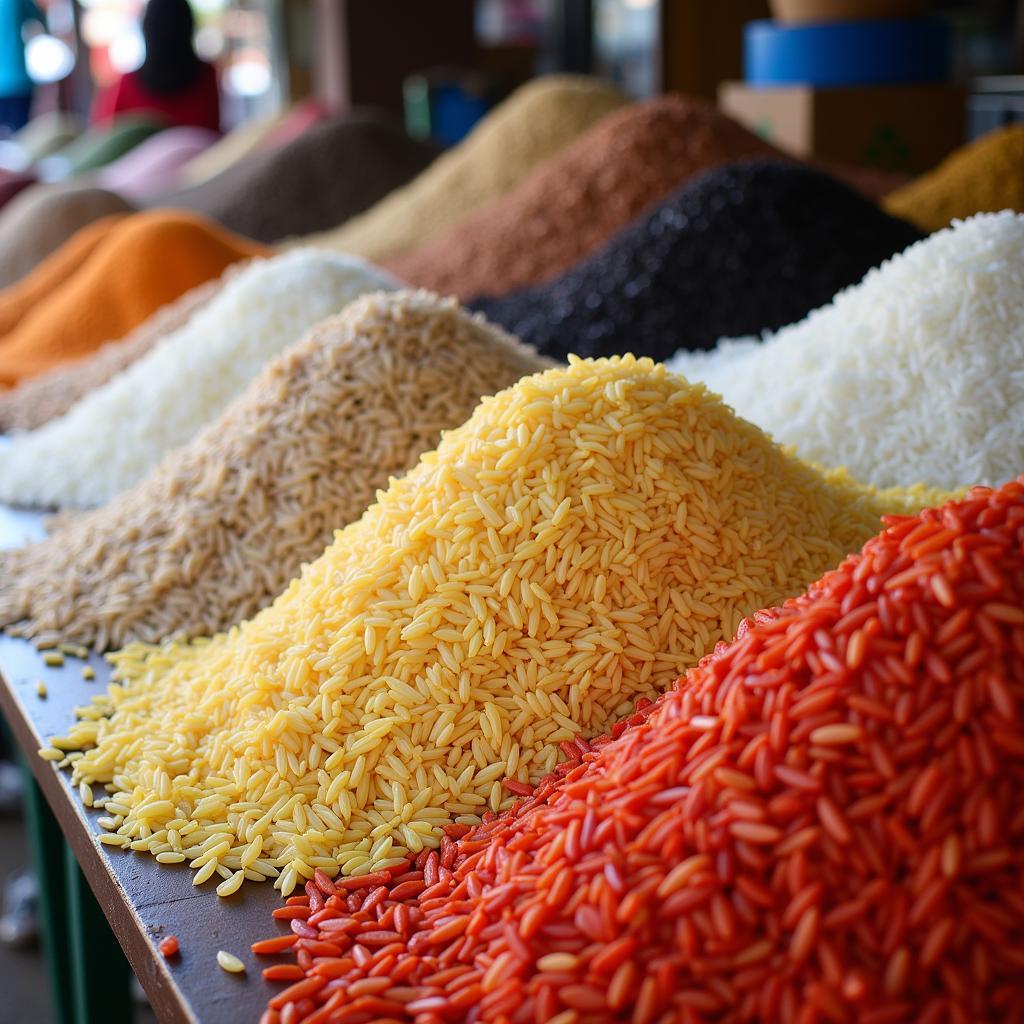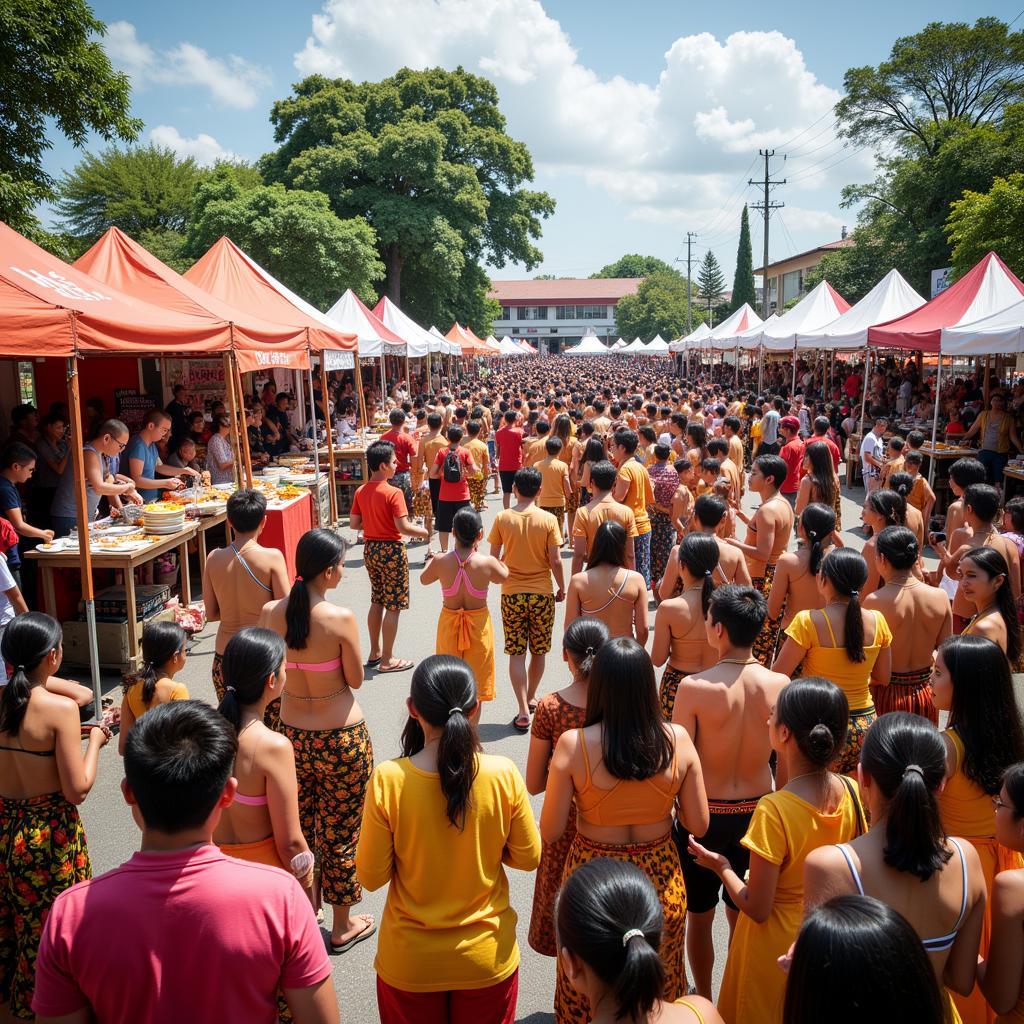Rice is more than just a staple food in Southeast Asia; it’s deeply woven into the cultural fabric of the region. From the fertile plains of the Mekong Delta to the emerald rice terraces of the Philippines, ASEAN countries boast a rich diversity of rice varieties, each with its unique flavor profile, cooking characteristics, and cultural significance.
A Legacy of Rice Cultivation in ASEAN
For millennia, rice cultivation has shaped the landscapes and societies of Southeast Asia. Archaeological evidence suggests rice farming emerged in the region as early as 4,000 years ago. This long history of cultivation has led to the development of countless rice varieties, each adapted to specific local conditions and culinary traditions.
 Farmers Harvesting Rice in Vietnam
Farmers Harvesting Rice in Vietnam
Exploring the Diversity of ASEAN Rice
From the fragrant Jasmine rice of Thailand to the nutty-flavored black rice of Indonesia, ASEAN offers a fascinating journey for any food enthusiast. Here’s a glimpse into some of the most iconic rice varieties from the region:
- Jasmine Rice (Thailand): Known for its delicate floral aroma and slightly sticky texture, Jasmine rice is a favorite for dishes like Thai green curry and mango sticky rice.
- Basmati Rice (India): While not exclusive to ASEAN, Basmati rice is widely enjoyed in the region, particularly in Singapore and Malaysia. Its long, slender grains and nutty flavor make it ideal for biryani and pilaf.
- Sticky Rice (Laos, Thailand, Vietnam): Also known as glutinous rice, this variety has a sticky texture perfect for desserts like mango sticky rice or savory dishes like Lao larb.
- Red Rice (Bhutan, Nepal): This unhulled rice variety, with its reddish-brown hue and slightly chewy texture, is gaining popularity for its nutritional benefits.
- Black Rice (Indonesia, Philippines): Often called “forbidden rice,” black rice has a slightly sweet, nutty flavor and is rich in antioxidants.
 Colorful Rice Varieties at an ASEAN Market
Colorful Rice Varieties at an ASEAN Market
The Cultural Significance of Rice
Rice is not merely a food source in ASEAN; it’s a symbol of life, prosperity, and community. Many cultural traditions revolve around rice, from planting and harvesting rituals to festive dishes prepared for special occasions.
- Rice in Festivals: Throughout ASEAN, rice plays a central role in festivals like Songkran in Thailand and Tet Nguyen Dan in Vietnam. Special rice-based dishes are prepared, and rice is often used in offerings and ceremonies.
- Rice in Daily Life: The act of sharing a meal, particularly a rice-based meal, is an important social custom in many ASEAN countries, strengthening family and community bonds.
- Rice in Folklore: Countless myths and legends across Southeast Asia highlight the importance of rice, often depicting its origins as a divine gift.
ASEAN Rice in the Global Market
ASEAN countries are among the world’s largest producers and exporters of rice. The region’s fertile lands and diverse rice varieties have positioned it as a key player in global food security.
- Rice Exports: Thailand, Vietnam, and Myanmar are among the top rice exporters globally, contributing significantly to the global rice supply.
- Economic Importance: Rice production and export are vital to the economies of many ASEAN countries, providing livelihoods for millions of farmers.
Facing the Future: Sustainability and Innovation in Rice Production
As the global population grows, ensuring sustainable rice production is paramount. ASEAN countries are at the forefront of addressing challenges like climate change, water scarcity, and food security.
- Sustainable Farming Practices: Promoting organic farming methods, water conservation techniques, and climate-resilient rice varieties are crucial steps towards sustainability.
- Technological Advancements: Research and development in rice breeding, precision agriculture, and post-harvest technologies are enhancing productivity and reducing environmental impact.
Conclusion
From the iconic pad thai to the comforting chicken rice, ASEAN rice continues to captivate taste buds worldwide. Beyond its culinary appeal, rice embodies the rich cultural heritage, economic significance, and spirit of innovation that defines Southeast Asia. As we savor the diverse flavors of ASEAN rice, let’s appreciate the generations of farmers and the intricate web of life that sustains this vital grain.
FAQs about ASEAN Rice
1. What is the most popular type of rice in ASEAN?
While preferences vary across the region, Jasmine rice from Thailand is widely recognized and enjoyed for its aroma and flavor.
2. Is all rice grown in ASEAN white rice?
No, ASEAN boasts a wide diversity of rice varieties, including white, brown, red, and black rice, each with unique characteristics.
3. What are some popular rice dishes from ASEAN?
Some beloved rice dishes from the region include Pad Thai (Thailand), Nasi Lemak (Malaysia), Hainanese Chicken Rice (Singapore), and Biryani (commonly found in Malaysia and Singapore).
4. How can I incorporate more ASEAN rice into my diet?
Experiment with different rice varieties to find your favorites. Try using Jasmine rice for stir-fries, sticky rice for desserts, or black rice for a nutritious salad.
5. Where can I learn more about ASEAN rice and its cultural significance?
Many online resources and books explore the history, cultivation, and cultural significance of rice in Southeast Asia. You can also find information on specific rice varieties and traditional recipes.
For further information about Southeast Asia, explore these related articles:
Have more questions about ASEAN culture or need assistance with your travel plans?
Contact us at Phone Number: 0369020373, Email: [email protected], or visit us at Thon Ngoc Lien, Hiep Hoa, Bac Giang, Vietnam. Our dedicated customer support team is available 24/7 to assist you.

